|
I realized that I was in serious trouble on two counts, guns and booze. What am I to do? I did want to board the ship but couldn't do it with 3 pistols and 2 bottles of champagne. I wasn't about to sell the champagne so my buddies and I had ourselves a "going away" party on the pier at Marseilles. There was no Army Regulation against drinking it, only against taking it on board. I guess we violated that regulation as we did take it on board although we got rid of it as soon as we got on board and located a latrine or "head" as its called on board ship.
We left the two bottles (empty) "dead soldiers" on the Pier at Marseilles as we slowly "staggered" up the gangplank of the St. Albans Victory. I also disposed of the 2 extra pistols. I had no problem getting rid of the P-38 Walther and the Italian Beretta on the dock. There were many soldiers on the pier without any guns to bring back so they were happy to purchase a real "combat gun".
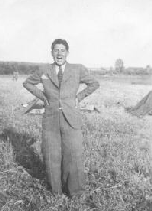
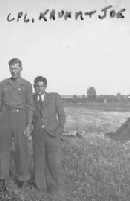
As the St. Albans Victory pulled out of the Marseilles Harbor I left the European Continent with many memories, some good, some bad. The last look was of the two "dead soldiers" I had left on the pier at Marseilles.
I thought of the day we visited the German Concentration Camp at Dachau, Germany. While we were in Czechoslovakia a group of us would take off on a weekend to visit places of interest in Germany. One of these trips in June of 1945 was to the notorious German Concentration at Dachau to see how the Nazis carried on their programs of exterminating the Jews, or as they labeled it "The Final Solution".
We were able to see where and how the Nazis carried out their "Final Solution" in dealing with the Jewish Problem. Our guide for the trip was our own "Gypsy Joe", a onetime resident of Dachau who had attached himself to "A" Company during the last weeks of the war. I guess you can say that we adopted him, outfitted him in a G.I. uniform and let him work as our translator and to supervise the Germans that we had working in our kitchen.
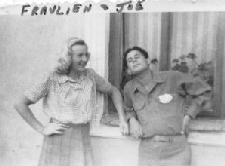
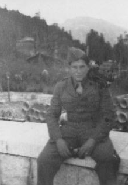
"Joe" spoke 4 or 5 different languages and had spent time in 3 or 4 Concentration Camps. He had survived all of them. He hated the Nazis and was very valuable to us during the closing days of the war as a translator and interrogator of German Prisoners.
When he heard that we wanted to go to Dachau he agreed to take us on a guided tour of the camp as he had spent some time there. He had been "on site" and could attest to the atrocities that took place there. He had undergone tortures there. It was a day I will never forget. Saw the parked Railroad Cars which brought the thousands of Jews to Dachau for annihilation. The Jews were brought in from all over Europe to the Crematorium at Dachau.
Saw the places where the corpses were hung up on meat hooks like animals, or sides of beef.
Stood in the "so called Shower Room" where thousands of Jews were gassed with the quick acting Cyclon gas. They did not get a shower, only death. After the gassing the bodies were taken to the Crematorium.
I stood in front of the oversized ovens and even saw some of the human ash that remained there.
Along one side of the room were thousands of urns that looked like flower pots without a rim around the top. Next to the urns were thousands of plaster disks numbered. Gypsy Joe told us that the officers in charge would send urns with ashes to surviving relatives.
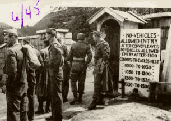
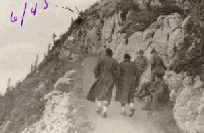
I did take one of the urns and a plaster disk but I wasn't quite up to taking some of the ashes from the ovens. Some of our people took ashes but I didn't have the heart to do so.
The day at Dachau made a deep impression on me. As the war was coming to a close I saw groups of striped uniformed "scarecrow" looking people wandering the countryside after they had been freed from the Concentration Camps. I once saw a group of striped "scarecrows" kill a sheep with their bare hands, rip it open and eat the heart and other internal organs; it is a real emotional and moving memory.
Another memory, that's hard to erase, was the day we lost Stephen Jackson, a member of the 1st Platoon. Incidentally the only member we lost all during combat.
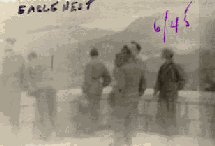
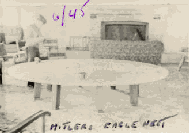
Stephen rode in our half track through France and Germany before we lost him in the Roer Campaign. We had been under intense 20 mm fire and had dismounted from our half tracks and were taking cover in the ditches alongside the road. We do not know why he raised up and was shot through the throat and died quickly. He was buried in a cemetery in Margraten, Holland. This was just a short way from where we had been stationed in Holland earlier in the year. Steve Jackson was an excellent soldier and well liked by everyone.
It was very hard for me to write a letter of condolence to his mother, a Mrs. Viona Hennig about the details of his death. I did continue to correspond with her after the war. In fact, when I got married in 1946 she sent us a beautiful lace table cloth as a wedding gift. We still have it, I think.
Another memory that I have was of my visit to Munich, Salzburg, Austria and Hitler's Mountaintop Retreat and Eagles Nest at Berchesgaten.
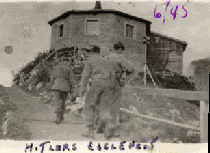
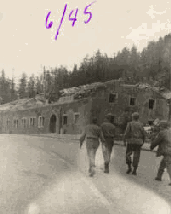
From the Eagles Nest you could see the mountains all around. Some of the soldiers in our group shot "Craps" on the big circular table that Hitler and Mussolini had gathered around, making their grandiose plans for world conquest.
While thinking the loss of Private Stephen Jackson to a 20 mm shell through his neck I would also like to remember two other of the casualties of the 1st Platoon while in combat. Two more men of the Platoon were casualties in addition to Schonger and Zawiza in our first engagement at Nennig-Berg in the Battle of the Bulge.
The second two were not wounded physically but they were emotional wounds, but just as damaging as being wounded by enemy fire. We had two men of the 1st Platoon break down emotionally from what was referred to as "Combat Fatigue". Lt. Campos suffered from this condition. He never returned to the Platoon.
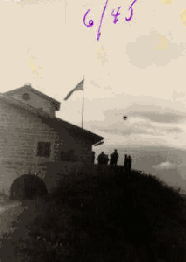
The first to break down was Sgt. La Verle Lee who led the 2nd Squad, he broke down during the Roer Campaign. A Dear John letter from home helped. We had some mine clearing jobs and Dragon's Teeth removal. We were done with our days work, were gathered in a German farmhouse and were trying to enjoy a meal of canned "C" rations. Suddenly, Sgt. Lee, in charge of the 2nd Squad, jumped up into the center of the room, pointed his rifle at us and started to talk "gibberish". We couldn't understand a word that he was saying but we did recognize the symptoms of a "nervous breakdown". The members of the 2nd Squad wrestled the Sgt. down and disarmed him of his rifle. He was turned over to our Medics who evacuated him to the rear for further diagnosis and treatment.
At the treatment center, to the rear, Sgt. Lee was treated for almost a month before he returned to "A" Company. He was never put in charge of the 2nd Squad. Cpl. John Moore, a very capable and stable non-com took over the 2nd Squad. Sgt. Lee became a member of the 2nd Squad. It later came out that Sgt. Lee had received a "Dear John" letter from his wife in Ohio. A "Dear John" letter referred to when a wife notified her husband that she had found a "new man" in her life and had "dumped" her husband. This probably contributed to the Sgts. breakdown.
The other soldier to suffer from "Combat Fatigue" was Private Rodriguez of Sgt. Austin's 3rd Squad. Private Rodriguez broke down just after we had crossed the Rhine River at Wesel after a heavy artillery bombardment. He ceased to function adequately as a soldier and was also evacuated to the rear by the Battalion Medics for treatment. He never did return to our Platoon. We assume that he was treated, sent home and discharged from the Service.
Some of my most frightening memories of the war were the times we were under fire from the German Artillery. There were times when we did receive fire from high caliber artillery from long range. This consisted of artillery fire, rocket fire, mortar fire, 20 mm fire and of course machine gun and rifle fire. The sound of the German 88th were the most frightening. The sound of the "incoming" fire was the most frightening. The sound of the enemy shelling was very hard on your nerves. You never knew where the next one would land. Luckily I escaped any hit. I do have a piece of shrapnel that came too close. It was imbedded in a tree three feet away.
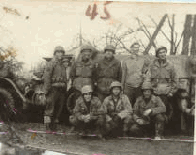
We were very lucky in that the only casualty suffered by the 1st Platoon from shelling was Lt. Campos and his breakdown after the intensive mortar shelling at Nennig-Berg. Steve Jackson was the only casualty and victim of a 20 mm attack. We must have been under God's protection in that our 1st Platoon was not affected by our mine laying or clearing and picking up the enemy mine fields. I attribute our safety record to good training and the concern we had for our men, I never took foolish risks. I never exposed my men to dangerous situations. I must have made some good decisions. At our 8th Armored Division Annual Reunions, some of my platoon commented that I made good decisions. That I usually did what was prudent for the Platoon.
The 1st Squad of the 1st Platoon did receive casualties when our own tanks backed over a stack of mines during our first combat experience at the "Schloss" at Nennig-Berg.
Considering that we daily worked with explosives like "T.N.T." and plastic "Composition C" on many jobs, some times at night and sometimes while under enemy fire. We were very lucky.
We usually carried hundreds of pounds of T.N.T. in our half tracks. Our 1st Squad Half Track was named Adolf's Coffin". It very easily could have been our coffin if we had received a hit from an artillery shell or rifle bullet. "B" Co. lost a half track with 8 men when a shell hit.
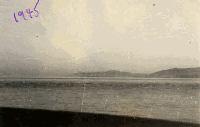

One night during the Roer Campaign we were setting off explosive charges of "T.N.T." right under the barrels of our Pershing Tank 75s which were firing at the Germans as we were setting the explosive charges to cut off the steel I Beam Obstacles which were holding up the advancing of our tanks.
These and many other memories come to mind, many others have faded from sight and may return at a later date in my record.
The trip home on the St. Albans Victory Ship was very uneventful. It was the South Atlantic in late fall. It was calm and warm all the way. We even slept on the deck. It felt good to see the Rock of Gibraltar as we passed through the Straits of Gibraltar. We saw the continent of Africa on our right and the continent of Europe on our left.
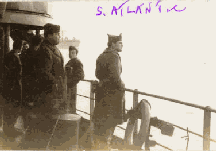
As the war was over, we were considered safe, and thus did not require "destroyer protection" like we had on our trip over in November of 1945. There were no submarines around, no blackout regulations. It felt good and we were very relieved to be on the way home. The only new thing were the schools of porpoises that seemed to follow us across the South Atlantic.
There was nothing to do but listen to our Southern Guitar Playing Friends. I bet I heard the song "Down Yonder" a thousand times. There was a lot of card playing. Most of us had not been paid for months so were just very interested spectators. Maybe that was just as well. There was nothing to drink on the trip home unless you were lucky to have been paid. We did find out why the ""Navy Personnel" didn't'' allow us to bring our alcoholic beverages on board. We found out that the ships crew, Navy Personnel, could for the right price find you a bottle of scotch or bourbon, for the right, steep price. Needless to say I was a "tee-totler" on that voyage home.
The trip home through the South Atlantic was of shorter length than our trip over in 1944. We thought that there might be some trouble on board because of the racial makeup of the "passengers". Almost half of the "passengers" were Negroes. There was not a bit of trouble. The two races existed for the whole voyage without any problems or conflict.
Things were so mild, that for many of the mild warm nites I took my blanket topside and slept on the deck, right amongst the blacks and the whites.
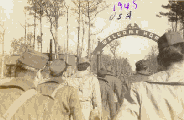
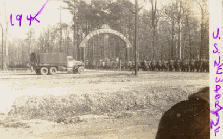
The day we had been looking for finally arrived. We docked at Newport News. An Army Band serenaded us from the Pier. We were very emotionally moved by the Reception. We were "debarked" and bussed to Camp Patrick Henry, Virginia. The war for John N. Jozsa of 1527 Leahy Street, Muskegon Heights, Michigan was almost over.
I figured there would be one more stop at a Separation Center, somewhere close to home where I would receive my long awaited Military Discharge from Service from the U.S. Army. God had been good to me and to the men under me. He had brought us through some very trying and hazardous times. Thank You, Lord, Protector of John N. Jozsa.
I still remember the first meal that they fed us at Camp Patrick Henry in Virginia. It was as "steak dinner" with seconds if you wanted. I think I did get back in line for the dinner that I had waited 4 ½ years for.
Went through the Orientation Program for Separation. After a few days, we received individual orders to the Army Separation Center at Camp Atterbury, Indiana. We arrived in Indiana and proceeded quickly through the Separation Procedure. They tried one more time to talk me into re-enlisting for 2 more years and a 2nd Lts. Silver Bars and 2 years in the Japanese Army of Occupation. They even offered a 90 day furlough before you had to leave for Japan.
I was emphatic and turned down their so called generous offer. I had had almost three months in Czechoslovakia and Camp Victoret in France of frustration with the U.S. Army. In no way was I going to reenlist for maybe more of the same in consideration. I had had it with the U.S. Army. All I wanted was that piece of paper that would Separate me from 4 ½ years in the U.S. Army.
John N. Jozsa had earned and deserved his Discharge Papers. On Dec. 10, 1945 John N. Jozsa received his official Honorable Discharge from the U.S. Army and I walked out of the front gate of Camp Atterbury with my duffel bag in hand and hitchhiked rides on the highway home. The Day was Dec. 10, 1945.
I arrived home at 1527 Leahy Street seven hours after I walked out the front gate of Camp Atterbury. I was safe and sound at last. The Odyssey of John N. Jozsa was over.
 John N. Jozsa John N. Jozsa
Added bits of information that come from the past . . .
Near the end of the war the 1st Platoon of the 53rd Engineers were assigned to the 17th Airborne Division to facilitate their sweeping of a heavily forested area in the Harz mountains. The Airborne moved through these wooded areas. The Germans set up road blocks by cutting down huge trees and dropping them across the road. Whenever the Airborne ran into one of these roadblocks they would call for the Engineers with their chain power saws and high powered winches and even our Bulldozer. We were never attacked as we worked because the 17th Airborne were a much decorated and battle scarred group. They provided the security while we removed the obstacles.
Our Platoon did receive some publicity from the time we spent with the 17th Airborne. During their sweep through the Harz Mt., they captured Franz Von Papen, one of the top Nazi leaders. He also was Hitler's top Diplomat who had represented Germany to all parts of the world. Von Papen was listed as one of the top German War Criminals was captured at his very elaborate hunting lodge in the most beautiful scenery in all of Germany. He was later tried at Nuremberg War Crimes trials after the war.
While in action, both sides used propaganda leaflets to try to convince the other side to surrender. These leaflets, at times, came down from the skies like rain. I gathered out some of them and have them in my scrapbook.
During my time in Europe, I did take many pictures of places and people. I also had myself "sketched" by two unknown artists. The first pencil sketch was by a Czech, named Steve who did some work for us while we were in Czechoslovakia. I heard from him after the war when he came to the U.S. and settled in New York City.
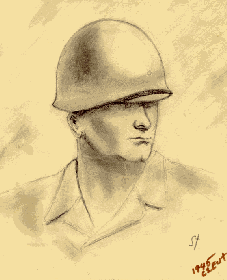
The 2nd sketch by a French artist in a bar in Marseilles. This was a crayon sketch. It was a very good likeness. It's still in my Photo Album. I think the sketch cost me a pack of Lucky Strikes, part of my ration as were never paid while in Camp Victoret there.
As I had mentioned earlier now I had "lost" my camera in Paris, I was unable to take any pictures for awhile.
After we crossed the Rhine River I "liberated" (a polite term for looted or appropriated) a very expensive but also very hard to operate, a Leica. The Leica at that time was the best camera being made anywhere in the world. I took a lot of pictures with it but had trouble getting good pictures. I never did quite master it. I took whole roll of film at Hitler's Eagle Nest at Berchergaten and a couple rolls in Czechoslovakia. The best pictures in Czechoslovakia were of the Fall Harvest Festival in Zbuch.
I did bring the Leica home with me. When the owner of the Heights Camera, a one Chester Kufta, found out that I had a Leica, one of the best cameras in existence at this time, he wanted it in the worst way. I told him that if I every decided to sell it, he would be first in line.
When I was going to get married in Nov. of 1946, Mr. Kufta made me a very fair offer, one that I couldn't refuse. The money from the selling of the Leica paid for some of the expenses of our wedding and our Honeymoon.
After the war ended, the point system for discharge went into effect. This involved the transfer of many people out of the Company who had been together for years, through Fort Knox, Camp Campbell and South Camp Polk, and finally combat action through France, Germany, Holland, Luxembourg and Czechoslovakia. While at Fort Knox I had received a newly enlisted recruit from Iowa (a Private Krug). Being his Platoon Sgt, I did have access to his Personnel 201 file. I saw that Private Krug had been released from a Reform School Situation to enlist in the Army. This has been a common practice through the years to give people with criminal records the option of taking the army or incarceration. His record listed him as a "trouble maker" and being "incorrigible".
At this stage of the war, the army needed "bodies" for training so the courts were releasing people from criminal prosecution to join the army. Private Krug turned out to be a fine soldier. During combat he performed courageously, led many patrols behind the enemy lines.
In time he was promoted to Corporal and then Sgt. in the 2nd Platoon under my good friend, Sgt. Kalwieth. When I was transferred out of the Company, I was able to convince Capt. J.J. Gettings, the Company Commander to have Sgt. Krug promoted to 1st Sgt. of the Company.
Before I left I called Sgt. Krug into the Orderly Room, wished him a lots of luck in his new job. At that time he confessed to me about his troubles in Iowa which had led to his enlistment in the U.S. Army. I then admitted to him that I had known of his "past" in Iowa from his first day in the Company. He couldn't believe that anyone could have put such trust in a jailbird. I listened and tears came from our eyes. His reaction to all this made me feel very good that I had had faith in him as a person.
During the action in the Roer Campaign we had an embarrassing experience that could have been a tragic one for our 1st Platoon. We had received orders to proceed to a certain town for some mine clearing work. We were barreling down the Highway. The road signs indicating that the City of Hamm (Hamelin – the Pied Piper of) was a few miles ahead.
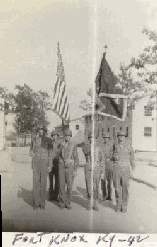
Suddenly a Military Police Jeep pulled up alongside our Platoon Jeep. I was riding in it with Lt. Santy and Cpl. Lashorn, the driver. The Military Policeman was very upset as he asked Lt. Santy. "Where in the hell are you going? Don't you know that the city of Hamm had not been captured yet and that you're within the range of the German artillery?"
The M.P. officer then ordered us to turn our vehicles, the Jeep, 3 Half Tracks and a truck, around and hightail it to the west. We executed the turn around maneuver in record time. Fortunately the roadsides had not been mined by the Germans so we suffered no causalities, only embarrassment. For a short time we were referred to as the "Spearhead Engineers Platoon" that tried single-handedly to capture Hamm.
Two days later the army newspaper, the Stars and Stripes, announced the capture of Hamm by one of our armored Divisions. We picked up a little puppy a few days later. We very appropriately named him Spearhead in honor of our almost tragic mistake.
While stationed at S. Camp Polk the following article appeared in our own Engineer Battalion Paper (Tarfu) which stands for "Things are Really Fouled Up". The paper name was a play on the army's saying "Situation Normal, All Fouled Up" (SNAFU). The article goes on;
Crowley became Temporary Engineer Headquarters last weekend
for Sgts. Sasb, Sgt. Zavislak, Cpl. Edwards, Cpl. Mathews, Sgt.
Rossini, Sgt. Patterson, Sgt. Jozsa and not to be forgotten Sgt.
Patterson all engaged in various occupations. Sgt. Paterson went duck hunting while the rest of the boys just went hunting.
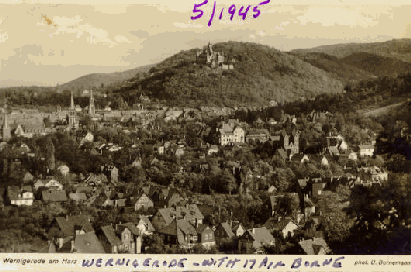
After the completion of the Roer Campaign, we ended up in the town of Wernigerode and ended up staying for a few days in a large factory which had a large P.A. System through the plant. One of our men took over the job of Disc Jockey and played us the latest German popular songs. Our favorite at that time was the song also popular with the German soldiers, the song was " Lili Marlene",
On first entering the plant we located a very large safe. With our Engineering ingenuity and some crowbars we finally got the safe open. We were disappointed in that all we found was a note which read. "This safe has been liberated by the 17th Airborne". We had been foiled again.
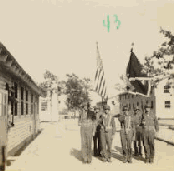
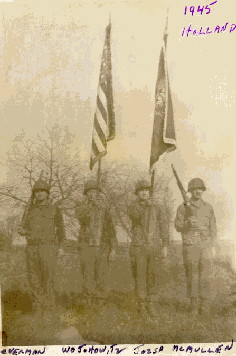
Another memory that I have of the 53rd Armored Engineer Battalion that I was fortunate to serve on the Battalion Color Guard. We had the honor of presiding at all dress parades, ceremonies for visiting dignitaries. The team consisted of four men. Two men carry the National Flag and the Battalion Colors while two men carry rifles. I carried one of the rifles.
The most touching ceremony that we participated in was when we "Color Guarded" at a Memorial Service for honoring the men we lost in combat. The services for the dead and wounded was very impressive. My eyes and the eyes of most of us were not dry. It was a moving experience.
I remember a more happier time when the Color Guard participated with the 8th Armored Division in a show when Bob Hope and his U.S.O. Troupe visited S. Camp Polk, La.
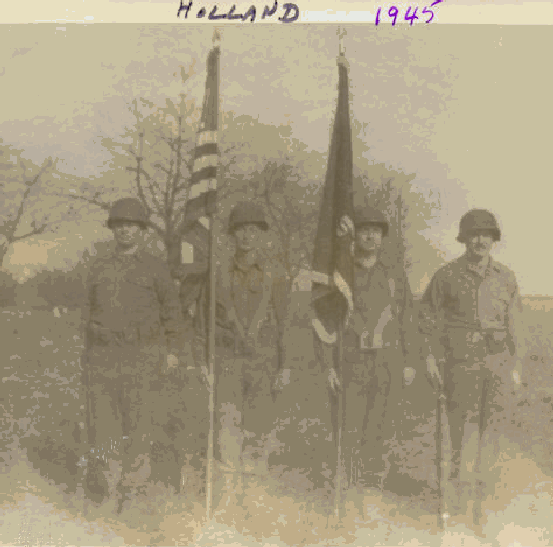
All the Battalions posed their Color Guards in front of the large stage. Thus the show went on behind us. We heard the show but saw very little as we were standing at Parade Rest with our flags and rifles. The U.S.O. Troupe consisted of Bob Hope, Francis Langford and Jerry Colona. I had at first participated at Fort Knox for "D" Company and then advanced to the Battalion Color Guard at Camp Polk, La. Continued serving when we shipped overseas.
The last time we acted as Color Guard for the 53rd Armored Engineer Battalion was in Holland when the Battalion honored its " war dead" in a Memorial Service in April of 1945.
|